 Lancaster
Lancaster  |
Media
|
Media
 Lancaster
Lancaster  |
Media
|
Media
Museum Collections
Aircraft in the Collection
Aircraft of Bomber Command
Canadian Built Avro Lancasters

Lancaster FM159 is a lucky Lancaster. One of 7374 built to help vanquish the Nazis, it was fortunate to have arrived for battle after the war in Europe ended, thus avoiding the flak and fighters that destroyed 3932 of its cohorts. Saved from the scrap yard, the aircraft enjoyed a fulfilling career with the Royal Canadian Air Force, travelling widely from bases on both coasts to play a valuable role during the Cold War. Replaced by a more modern aircraft, FM159 again escaped the scrap yard to become a town's landmark, watching the highway traffic pass by for thirty-one years. Finally, FM159 found itself dedicated to a Canadian war hero and the centrepiece of a museum telling the story of those who served in aircraft like it during the Second World War. |
During the early years of the Second World War, the British and their Allies were building as many aircraft as possible. In a surprisingly short time, thousands of aircraft of several types, including four-engined Lancaster Bombers, were being produced in Canada. For a country still largely agrarian and just recovering from a decade of depression, the challenge that was met was immense. Eventually Lancaster production reached the level of one aircraft per day and the project employed ten thousand people. A total of 430 were built and 105 were lost in action.
Strangely, as the Canadian-built Lancasters that had operated during the war were returning home, newly built aircraft such as FM159 were being flown to England, even though the war in Europe had ended. After spending four months in England, FM159 returned to Canada, arriving safely at Yarmouth, Nova Scotia to join others in temporary storage. However there was concern that the damp, salty climate of the Maritimes was beginning to cause corrosion and it was decided to fly hundreds of the bombers to a drier climate.
Residents of western Canada must have been shocked to hear the roar of the huge warplanes as they travelled across the prairies. The aircrew aboard knew the horror of war, but they had beaten the odds and survived and were understandably elated. As they crossed the prairies and before landing their aircraft for the last time, they buzzed towns and farms at extremely low level, frightening both residents and livestock.
Numerous Lancasters, including FM159, landed at the former training base at Pearce, Alberta, northeast of Fort Macleod. Many were sold to farmers. A Lanc could be purchased for a few hundred dollars and its parts put to many uses on the farm. To begin with there was lots of oil and hydraulic cylinders that could be adapted to various uses around the farm. The aircraft also provided a seemingly endless supply of wire, metal tubes, and sheet aluminum. Some of the more novel ideas were placing Lancaster tail wheels on threshing machines, using crew door ladders for checking the level in grain bins, placing bomb-bay doors as borders of flower gardens, using propeller spinners as plant pots, and incorporating escape hatches (with windows) into the construction of outhouses.
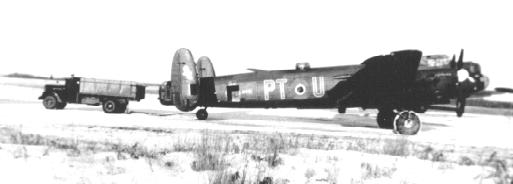
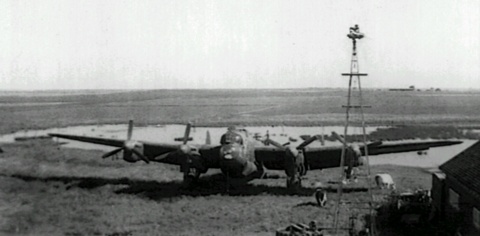
Being a low-time Lancaster, FM159 was saved from the fate of becoming a farmer's hardware store, On March 18, 1946, it made a short hop to the former training base at Fort Macleod, and was placed in storage.
FM159 was recalled for duty as a result of the international situation in the early 1950's. Following the increase in tension between East and West, the RCAF ordered the modification of seventy Lancasters to become maritime reconnaissance aircraft and play an anti-submarine role. The modifications included upgraded electronics and auxiliary fuel tanks fitted in the bomb bay. A silver paint scheme completed the conversion and FM159 emerged as a modern maritime reconnaissance aircraft.
From October, 1953 until early 1955 it served with No. 103 Search and Rescue Unit based at Greenwood, Nova Scotia. Then there were more modifications including the installation of a new radar system that enabled a snorkelling submarine to be detected at a distance of 20 nautical miles and FM159 was transferred to the west coast to begin service with No. 407 Squadron. The threat posed by Soviet submarines in Canada's Pacific waters was being countered by Lancasters based at Comox on Vancouver Island. As well as maritime reconnaissance, the squadron was also tasked with search and rescue and other duties.
Almost immediately, FM159 was off on what was one of its most exciting adventures. Flying over Canada's high Arctic, an ice observer charted the colours, cracks, leads, and movement of the sea ice so that the Dew Line radar sites could be re-supplied. The flights were lengthy, some as long as ten hours.
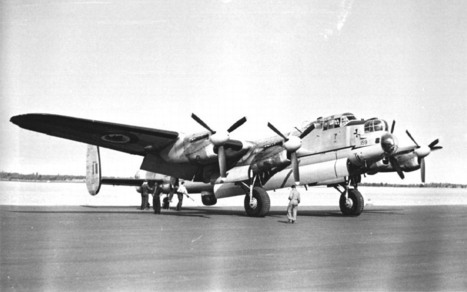 FM159 in Yellowknife, June 28, 1955. [ courtesy Norm Sharratt ] |
FM159's longest flight concluded with an unscheduled visit to the northernmost point in Canada, Alert, on the northern tip of Ellesmere Island just 490 miles from the north pole. While returning from a long patrol to their base at Resolute Bay on Cornwallis Island, Captain Harry Addison received word that the airfield was experiencing a "white out." He was advised to fly to Thule, Greenland. Then about half an hour out of Thule, Harry was told that they were experiencing zero visibility. He then asked for another alternate and was advised that the weather at Alert was forecasted to improve. But Alert only came on the radio every four hours so they didn't know for sure. |
It was a 500 mile flight and the navigator's maps didn't go that far north. According to Harry Addison, "Freddy Pineau, the flight engineer, was frantically doing all sorts of engine configurations to increase our flying time as we were getting critically low on fuel. About forty miles out of Alert they came on with their regularly scheduled weather broadcast and we were relieved to hear that Alert was practically clear. Never having landed a Lancaster with so little fuel on board, we must have floated two thirds of the runway before touching down. After a few "Hail Mary's" the pale faces returned to colour and, as we turned off the runway, number four engine died from lack of fuel. We had landed after a flying time of 12 hours 25 minutes. Needless to say we were all relieved to be on the ground."
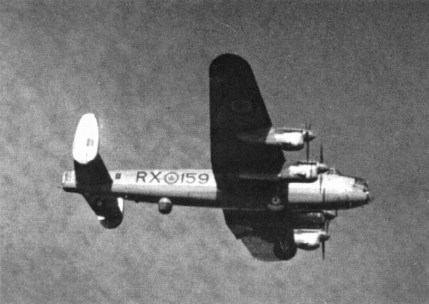
|
FM159 had another close call in 1956 when an engine exploded and burned one foggy night over the Pacific. Then, while returning to base, all electrics and navigation was lost. Pilot Bert Clark recalled, "It's a strange feeling to be moving along at 180 knots into a black void not knowing where you are." Eventually they followed another aircraft home, passing through the Straits of Juan de Fuca at 300 feet without being able to see the lights of Vancouver. RX 159 in its No. 407 Squadron markings. |
During 1956, FM159 participated in an exercise designed to test the capability of Canadian and American interceptor squadrons. After leaving Comox and travelling north into the interior of BC, pilot Fred Burton dropped down into the valleys of the Rockies to avoid detection by radar. He recalled, "The Canadians did catch us and we were jumped by CF-100's. We continued on our southerly track and crossed into Washington State with no further interception. We then climbed to about 20,000 feet and began our simulated bomb run over the city of Spokane. We made three passes before a USAF F86 came up to see who we were!"
Later that year, FM159 searched for a Trans Canada Airlines North Star that went down after leaving Vancouver with sixty people aboard included many players from the western all-star football team.
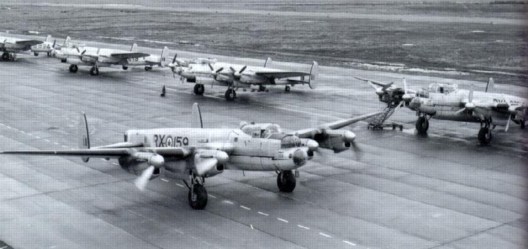
FM159 travelled widely during those years including trips to Alaska and to the British Isles to take part in anti-submarine exercises. Flight engineer Duke Dawe recalled a problem while flying near London. "The crystals for the radio were kept in a nice metal box with the frequencies labeled next to them. All went well on the first crystal change, but then the radio operator opened the box upside down, and all the crystals fell to the floor. What a mess! Needless to say we flew right through London control without talking to anyone. They must have had to divert all the traffic away form us."

The Lancaster era at Comox drew to a close in 1958 and it was with some nostalgia that F/L Brooks and flight engineer Duke Dawe left Comox, flew across the mountains, and parked FM159 at RCAF Station Calgary. The aircraft had acquired a total of 2068 hours since its overhaul in 1953. Duke recalled that leaving Lanc159 was a "rather moving experience." He had flown in the aircraft 62 times, accumulating a total of 224.5 hours and he, "always had a very great feeling for her." Later a civilian crew flew the aircraft to the former BCATP base southwest of Vulcan where its engines and props were removed and the aircraft was to be scrapped.
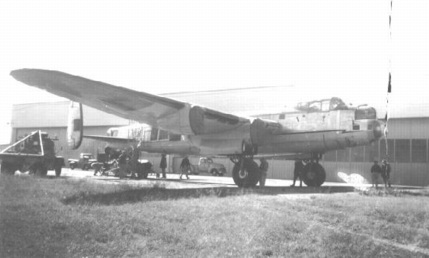 |
But luck was with FM159. In 1960, George White of Nanton had the idea of acquiring an aircraft as a war memorial and tourist attraction for his town. After hearing that FM159 was to be scrapped he, together with Howie Armstrong and Fred Garratt, purchased the bomber for $513. Nanton volunteers at the old Vulcan Aerodrome preparing FM159 for its trip to Nanton. |
|
George recalled that they realized that the Lancaster's main wheels were too far apart to permit travelling along the roads. So the Nanton volunteers waited until the crops were all harvested, put the tail wheel in the back of a truck, and towed the bomber backwards across the fields. Two fencing crews were organized, one to take down the barbed wire fences ahead of the aircraft and a second to put them back up again. One of the more interesting challenges was easing the aircraft down the banks of the Little Bow River, through the ford, and up the other side. FM159 Crossing the Little Bow river. ==> |
 |
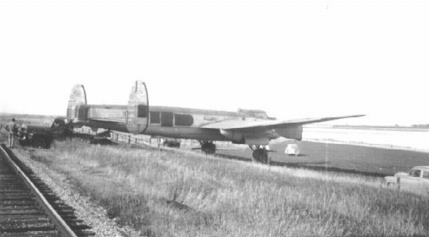 |
Late in the day FM159 passed between the south end of Connemara Lake and Mosquito Creek and reached the CPR tracks where the strange procession stopped for the night. Early the following morning the aircraft was pulled across the tracks and up onto Highway No. 2. It was smooth sailing from there and triumphantly, but likely somewhat uncomfortably, Lancaster bomber FM159 entered the Town of Nanton and was parked by the side of the highway. FM159 Crossing the tracks. |
When FM159 arrived in Nanton it was complete and could have flown had the engines and propellers not been removed. Two years later it was a gutted shell, thieves having removed the instruments and interior equipment and vandals having broken the cockpit, turrets, and bomb-aimers perspex, and torn the fabric of the control surfaces. The aircraft was on the edge of town at the time and despite efforts by Fred Garratt and others, there was no stopping the vandalism.
In 1962 volunteers began to put FM159 back on the road to recovery from its sorry state. Engines and propellers were purchased and installed. The aircraft was placed on steel mounts, its tail high in the air to limit access. Fortunately those in charge took the time to ensure that the aircraft would not be damaged. Steel mounts were fabricated and the aircraft continued to rest on its landing gear.

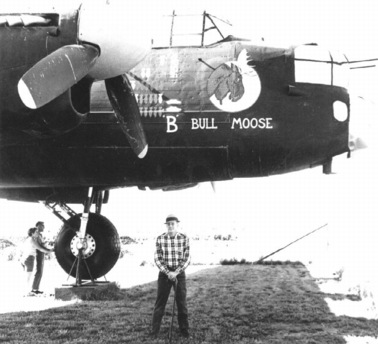 |
Harry Dwelle fabricated aluminum "windows" to cover the broken perspex. This was most important as bird droppings cause rapid corrosion in an aluminium airplane. Ray McMahon, together with his family and friends, repaired the exterior as much as possible and painted the aircraft. Ray McMahon in the late 1960's. |
The trio that purchased FM159 then donated the aircraft to the Town. Over the following twenty years volunteers and service clubs did what they could to keep FM159 looking its best as millions of people drove by on Highway No. 2 and the "Nanton Bomber" became a symbol for the Town. Although displaying postwar markings together with a wartime colour scheme, FM159 was now safely mounted and fenced. |
 |
 |
During the 1980's interest from outside Nanton was being shown. Offers to acquire the aircraft had been received from several individuals and even from her previous owners at Comox. However the Town rejected these advances and in 1985 looked again to George White for leadership, asking him to see if he could form an organization to, "take care of the bomber." FM159 in the late 1970's. |
George wrote an article in the Nanton News asking if anyone was interested in helping. He was overwhelmed with the response and the Nanton Lancaster Society was formed.
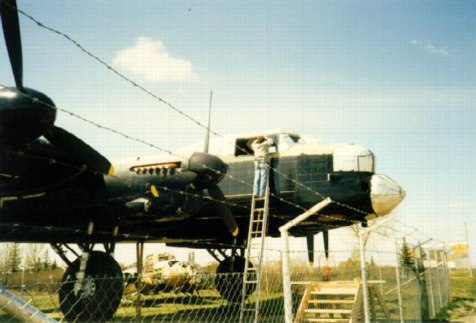 |
At this time no one had been in the aircraft for twenty-five years and virtually no one in Nanton knew anything about Lancasters in general, or FM159 in particular. But soon related artifacts were on display and Lancaster T-shirts and caps were for sale in the local tourist information booth. The Society had also made the decision that the best way to, "take care of the bomber" was to restore it to its wartime configuration as the centrepiece of an air museum -a rather ambitious undertaking for a community of fewer than 2000 people. "Open Bomber Days" were held featuring tours through FM159. These were most successful with long lines forming at the ladder leading to the cockpit. The aircraft's role in the education of future generations had begun. |

In 1991, through the co-operation of the three levels of government, Legion Branches, corporations, and thousands of individuals, a museum building was completed. On a bright Saturday morning, FM159 was rolling again, this time towed by a farm tractor into her new home. |
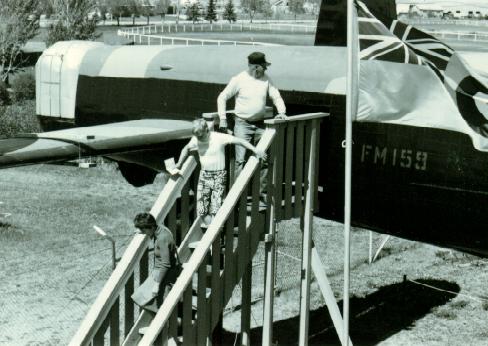
|
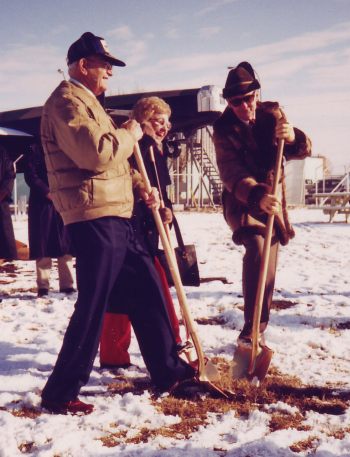
|
(l-r) George White, Mrs. Fred Garratt and Howie Armstrong turn the sod for FM159's new home. |
FM159 on its gear again, the night before it was placed in the new building. |
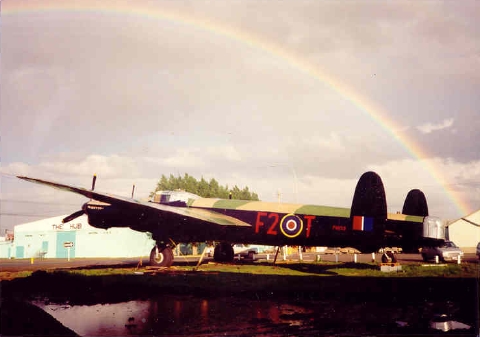
|
Reflections of FM159, the night before it was placed in the new building. |

|
Wartime Lancaster pilot and Society Director, Joe English, is in the cockpit again as FM159 is towed to its new home. |

|
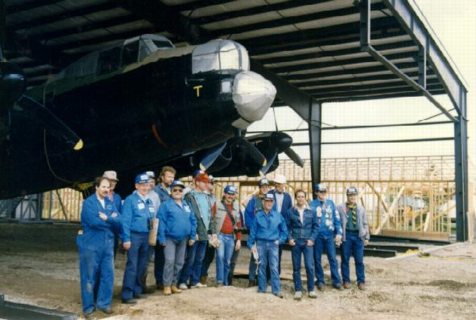 |
FM159 and friends. |
FM159 is dedicated to the memory of Ian Bazalgette, a Lancaster pilot who was awarded the Commonwealth's highest award for valour, the only Albertan to be so recognized during WW II.
Ian was born in Calgary, educated in Britain, and joined the Royal Air Force. After completing a tour of operations, "Baz," as he became known as, volunteered for additional service with the Pathfinder Force.
Bazalgette's Lancaster was hit by flak while approaching a V-1 Rocket site. Both starboard engines were knocked out and fires started. As the Master Bomber and Deputy Master Bomber were out of action it was up to Baz to mark the target for the remainder of the force. This he did but then the aircraft went into a violent dive. He regained control but soon the fire spread and a third engine stopped running. He ordered four of his crew to parachute but chose to remain on board in an attempt to save the others who were injured and could not jump. Baz managed to land the aircraft but it exploded and all aboard were killed. The surviving crew members evaded enemy soldiers and made their way to the allied forces. The story was told and the Victoria Cross awarded. The citation reads that, "His courage and devotion to duty were beyond praise."
Larry Melling served with Ian. He recalls being impressed by him on his first day at the squadron when he walked into the Flight Office, "He had a tremendous sparkle in his eye is the best way to describe it. He stood out amongst the people who were there. He was an inviting sort of a person, a person that you wouldn't hesitate to approach. He was always the first to volunteer for a job, no matter what sort of job it might be."
A Dedication Ceremony was held in 1990. Mrs. Ethel Broderick, Ian's sister, unveiled a plaque and the markings of the Bazalgette aircraft (F2-T) were unveiled by two of Baz's crewmembers, Chuck Godfrey and George Turner.
FM159's friends from No. 407 Squadron were represented on this special day as well. The squadron's c/o, Lt. Col. Terry Chester, spoke at the ceremonies and a squadron Aurora performed a flypast together with a CF-5 jet.
Early in the history of the Nanton Lancaster Society a decision was made to restore FM159 to its wartime configuration as a memorial to those who served with Bomber Command. The aircraft has been inspected by engineers and found to be in very sound condition. With this in mind, restoration has proceeded with the goal of having a fully restored, static display aircraft that is capable of engine run-ups.
Society members have scoured southern Alberta, visiting the barns and junk piles of farms whose owners had purchased Lancasters after the war. This has resulted in an extensive collection of parts that are used in the restoration of the aircraft and for trading with other museums.
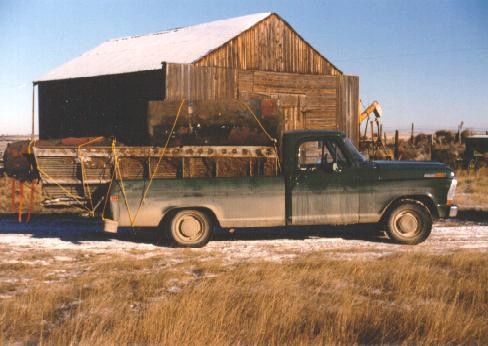
The first major restoration project involved the pilot's instrument panel. Jon Spinks acquired the instruments in England and by late 1987 had completed the beautifully restored panel. Extensive work has since been done to restore the aircraft's mid-upper and rear gun turrets. Following three years of work, the rear turret was made fully operational. The perspex in the cockpit canopy and bomb aimer's position has been replaced as has that in the gun turrets. After suffering from water damage over the years, the navigator/wireless operator's table was removed and rebuilt. Over a twelve-year period that began in 2003 the Lancaster's four Merlin engines were restored to runnable and the aircraft became taxiable. The hydraulic system was restored so that bomb-doors can be opened and closed and flaps deployed. Much restoration work has been done on the interior as well including installation of the ammunition tracks to the rear gun turret and installation of all the equipment at the wireless operator, navigator, flight engineer, and bomb-aimer's positions.
It's important that all this has been done by volunteers working on Tuesday evenings. Restoring a World War II bomber is a huge undertaking, particularly when the museum itself has been under constant development. Numerous other aircraft have been acquired and restoration projects completed during the time that the Lancaster has been under restoration.
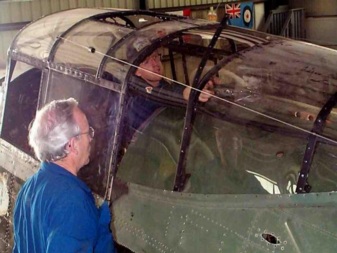 finish off FM159's canopy. |
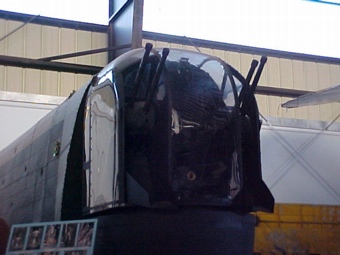 The rear gun turret has been restored to operational status. |
Restoring a World War II bomber is a huge undertaking, particularly when the museum itself has been under constant development. Numerous other aircraft have been acquired and restoration projects completed. Major building and expansion projects are frequently underway.
FM159 now enjoys a fulfilling role as the centre-piece of the Bomber Command Museum of Canada (formerly the Nanton Lancaster Society Air Museum). The museum features a dozen other aircraft as well as artifacts, aviaition art, and interpretive displays that tell the story of Bomber Command and Canada's contribution to the air war. Hundreds of thousands of people have visited and all have left knowing more of the sacrifices that were made by the aircrew of Bomber Command.
FM159 remains the only Lancaster in the world that welcomes supervised visitors to its interior. During one of the "Open Bomber Days," two Lancaster veterans who had not seen each other since WW II met and embraced inside the aircraft. Over the years FM159 has witnessed countless other memorable moments as aircrew have relived their memories. These include both the horrors they went through as well as happier times that forged lifetime bonds with their fellow crewmembers. Some Bomber Command veterans freely tell of their experiences as they visit, others quietly keep their memories to themselves. Some are brought to tears and others have just walked around the aircraft, unable to bring themselves to step inside.
Ground crew, women who served with the RCAF, and others who played important roles with Bomber Command have toured the museum. Men and women who worked for Victory Aircraft have visited FM159, some pointing to a particular part and saying, "I built that," or "I riveted those pieces together." Former aircrew who flew aboard FM159 during her postwar service are regular visitors and recall their valuable service during the Cold War.
Each year classes of school children sit under her wing to be told what freedom means and the role of Canada's Airforce in the past and today. Air Cadet Squadrons and veterans' and seniors' organizations visit regularly as well.
Dozens of special events have been held under FM159's wings. The bomber hears moving speeches of Remembrance and presides over solemn ceremonies. Guests seated on her wing have heard the stirring RAF Marchpast during band concerts, a choir has sung, "Coming in on a Wing and a Prayer" from her cockpit, and a couple was married on the starboard wing.
But most importantly, the aircraft has been host to thousands of aircrew and their families as they visit the museum to honour, to learn, and to remember. In many cases the families have heard, for the first time, of a father's or grandfather's role in Bomber Command. World War II touched the lives of all Canadian families and the Royal Canadian Air Force will always be a significant part of many family histories. Each year thousands of visitors come to the museum knowing that the Lancaster played a crucial role in the life of a parent, grandparent, uncle or aunt.
FM159 and its museum tell their stories well. Visitors are often in awe of both the aircraft and those who served. They leave the museum with increased appreciation of the successes and sacrifices associated with Bomber Command.